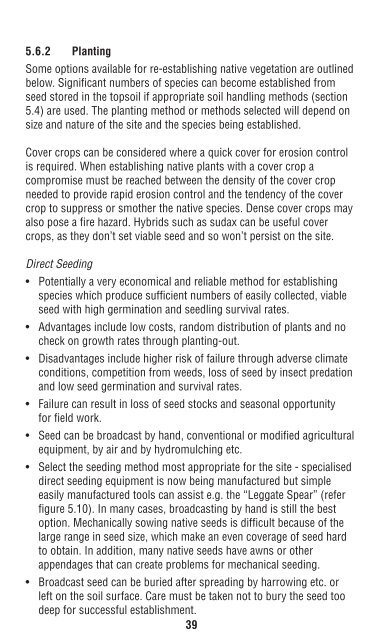Mine Rehabilitation Handbook - Mining and Blasting
Mine Rehabilitation Handbook - Mining and Blasting
Mine Rehabilitation Handbook - Mining and Blasting
Create successful ePaper yourself
Turn your PDF publications into a flip-book with our unique Google optimized e-Paper software.
5.6.2 Planting<br />
Some options available for re-establishing native vegetation are outlined<br />
below. Significant numbers of species can become established from<br />
seed stored in the topsoil if appropriate soil h<strong>and</strong>ling methods (section<br />
5.4) are used. The planting method or methods selected will depend on<br />
size <strong>and</strong> nature of the site <strong>and</strong> the species being established.<br />
Cover crops can be considered where a quick cover for erosion control<br />
is required. When establishing native plants with a cover crop a<br />
compromise must be reached between the density of the cover crop<br />
needed to provide rapid erosion control <strong>and</strong> the tendency of the cover<br />
crop to suppress or smother the native species. Dense cover crops may<br />
also pose a fire hazard. Hybrids such as sudax can be useful cover<br />
crops, as they don’t set viable seed <strong>and</strong> so won’t persist on the site.<br />
Direct Seeding<br />
• Potentially a very economical <strong>and</strong> reliable method for establishing<br />
species which produce sufficient numbers of easily collected, viable<br />
seed with high germination <strong>and</strong> seedling survival rates.<br />
• Advantages include low costs, r<strong>and</strong>om distribution of plants <strong>and</strong> no<br />
check on growth rates through planting-out.<br />
• Disadvantages include higher risk of failure through adverse climate<br />
conditions, competition from weeds, loss of seed by insect predation<br />
<strong>and</strong> low seed germination <strong>and</strong> survival rates.<br />
• Failure can result in loss of seed stocks <strong>and</strong> seasonal opportunity<br />
for field work.<br />
• Seed can be broadcast by h<strong>and</strong>, conventional or modified agricultural<br />
equipment, by air <strong>and</strong> by hydromulching etc.<br />
• Select the seeding method most appropriate for the site - specialised<br />
direct seeding equipment is now being manufactured but simple<br />
easily manufactured tools can assist e.g. the “Leggate Spear” (refer<br />
figure 5.10). In many cases, broadcasting by h<strong>and</strong> is still the best<br />
option. Mechanically sowing native seeds is difficult because of the<br />
large range in seed size, which make an even coverage of seed hard<br />
to obtain. In addition, many native seeds have awns or other<br />
appendages that can create problems for mechanical seeding.<br />
• Broadcast seed can be buried after spreading by harrowing etc. or<br />
left on the soil surface. Care must be taken not to bury the seed too<br />
deep for successful establishment.<br />
39<br />
Figure 5.10<br />
• Seeding rates will depend on species, site conditions, desired<br />
density of vegetation <strong>and</strong> viability of seed; seed should be tested to<br />
establish approximate viability percentage.<br />
• Numbers of seeds per unit weight is highly variable (e.g. Eucalyptus<br />
species may vary between 3500/2,500,000 seeds/kg).<br />
• Field establishment rates from direct sowing are typically 1-5% for<br />
fine seed species <strong>and</strong> 5-10% for coarse seed species. An estimate of<br />
the required sowing rates can be calculated from the number of<br />
seeds per unit weight, estimated field establishment rates <strong>and</strong> the<br />
desired density of plants.<br />
• Bulking of fine seed with s<strong>and</strong>, sawdust, etc will assist in even<br />
distribution. Pelleting larger native seed to assist in sowing <strong>and</strong><br />
reduce wind blow has been successfully achieved.<br />
Bradysporous Species<br />
In some Australian ecosystems, many species retain their seeds on the<br />
plant in woody capsules that open after fire (Bradysporous species).<br />
Where species with bradysporous seeds are an important part of the<br />
ecosystem, the vegetation can often be harvested using a forage<br />
harvester before clearing <strong>and</strong> spread on areas being rehabilitated.<br />
40
















